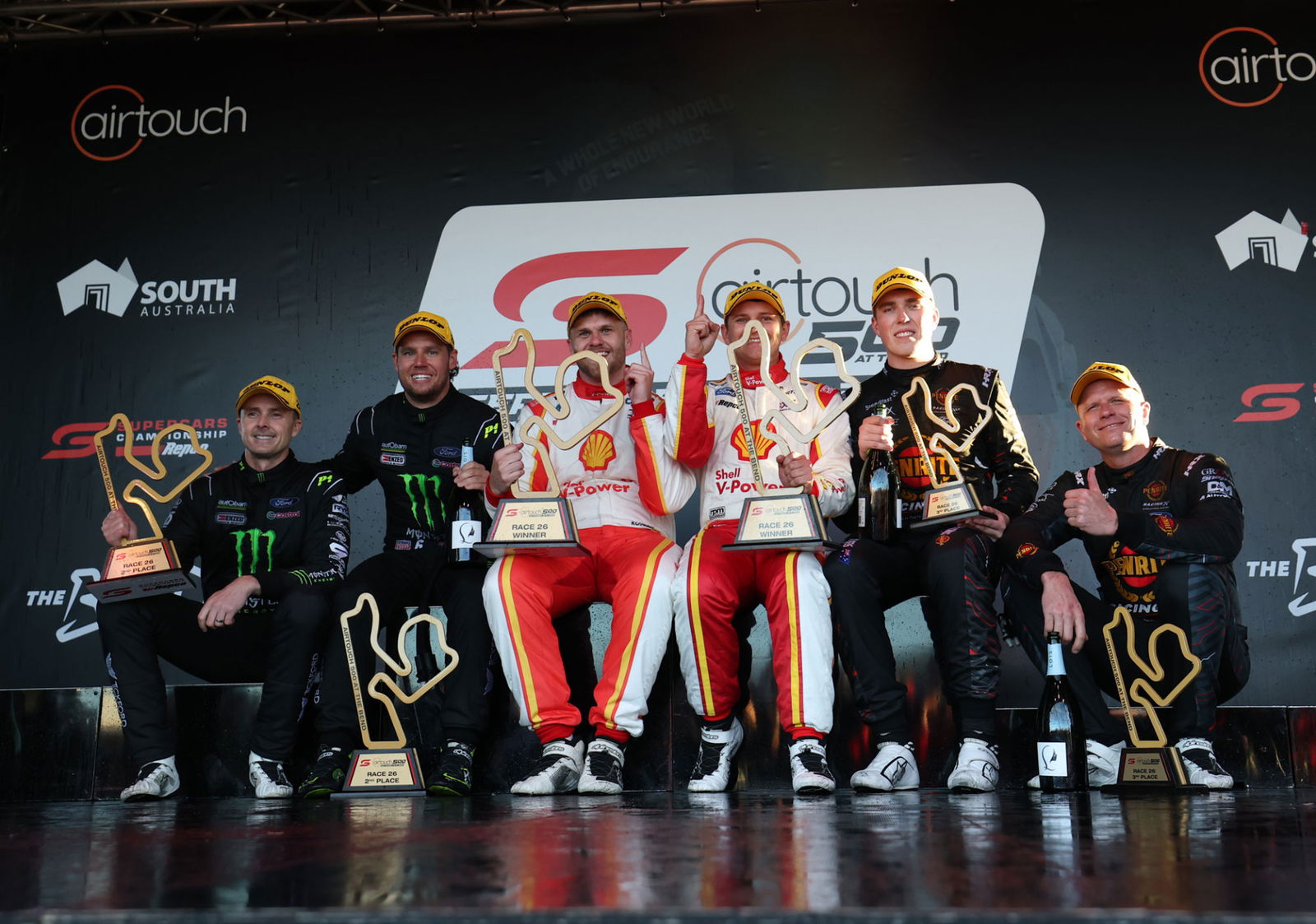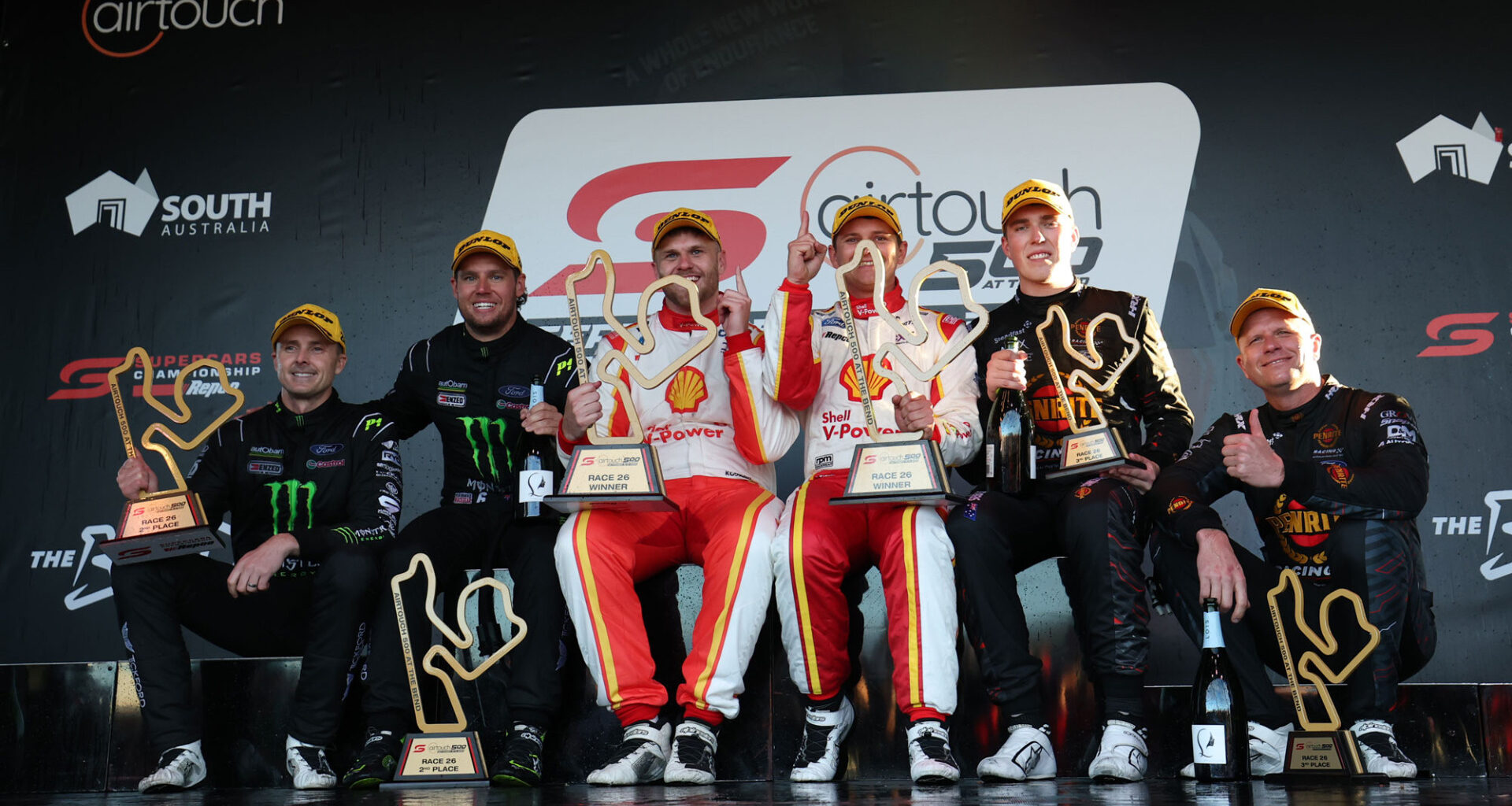
The podium from the inaugural AirTouch 500 at The Bend. Image: Supplied
We’ve teamed up with data analytics firm The B Pillar to dig a little deeper into the race.
The inaugural AirTouch 500 at The Bend is unlikely to be remembered as a classic and marked the first time since 1990 that ‘the 500’ was devoid of any Safety Car periods.
However, that and the low tyre degradation (at least compared to the former home of the 500 at Sandown) gives us some relatively clean data to look at.
On that basis, we’ve ranked the co-drivers using an average lap time taken from 80 percent of their total laps (minus the opening lap and any pit in/out laps).
There are of course many variables not factored in, such as traffic, strategy, fuel saving and car issues, so consider this a snapshot rather than a definitive study.
It should be no surprise, however, to see Dick Johnson Racing’s winning co-driver Todd Hazelwood top the order.
Co-driver
Average
Todd Hazelwood
1:53.192
Jobe Stewart
1:53.326
Jamie Whincup
1:53.388
Garth Tander
1:53.431
Mark Winterbottom
1:53.443
Scott Pye
1:53.454
Tim Slade
1:53.506
Jarrod Hughes
1:53.509
Jayden Ojeda
1:53.543
Cameron McLeod
1:53.558
James Moffat
1:53.583
Lee Holdsworth
1:53.604
Fabian Coulthard
1:53.661
Harri Jones
1:53.725
Nash Morris
1:53.770
David Russell
1:53.825
Tony D’Alberto
1:53.856
Craig Lowndes
1:53.892
Dale Wood
1:53.910
Jordan Boys
1:53.959
Rylan Gray
1:53.963
Jack Smith
1:54.036
Brad Vaughan
1:54.077
Jack Perkins
1:54.266
Zak Best
1:54.269
Declan Fraser
1:54.511
Aaron Seton
1:55.203
Hazelwood put in a sublime performance alongside Brodie Kostecki, overcoming a slow start to take the lead in the opening stint and drive away from the field.
It was an impressive case of picking up where he left off last year, despite a change of teams and revised driver weight rules that took away a previous advantage.
Jobe Stewart, who effectively replaced Hazelwood at Erebus Motorsport, is ranked second here after a highly impressive first main game start alongside Cooper Murray.
Stewart recovered from a tricky opening stint in which he damaged a tyre early to put down a marker against the primaries that has set him up for a full-time promotion in 2026.
However, it should be noted that the alternate strategy used by this car gave Stewart better conditions than his fellow co-drivers enjoyed as the circuit improved throughout the race.
Jamie Whincup ranks third here on speed and was also slightly off-sequence, as a refuelling issue meant he did three stints (and was the only true co-driver to do more laps than their primary).
Erebus rookie co-driver aces audition for full-time seat
He also ran off-track during his third stint – the sort of error that could have been a race-ender among the concrete walls at Bathurst.
Fourth-ranked Garth Tander lamented his own early misjudgement that cost four places, but he made up for it with speed (including the fastest lap by any co-driver) that set up a podium for the #19 Grove Racing Mustang.
Mark Winterbottom (ranked fifth) and Tim Slade (seventh) were both strong performers, as is expected for drivers in their first year out of full-time seats.
Between them in the ranking is Scott Pye, whose effort was more impressive than this order suggests given he had to fight through from a lowly 16th on the grid.
The remainder of the top 10 consists of young guns Jarrod Hughes, Jayden Ojeda and Cameron McLeod, who all recovered from early setbacks to out-pace several seasoned co-drivers.
Hughes’ performance went somewhat unnoticed given the excitement around Erebus teammate and fellow rookie Stewart, but is worth underlining.
POLL: Which co-driver impressed you most at The Bend?
Fellow debutants Harri Jones (14th) and Nash Morris (15th) were notably close to their Team 18 and PremiAir Racing stablemates, with the latter just ahead of David Russell on this metric.
Triple Eight veteran Craig Lowndes had his troubles on Sunday but was far from the slowest in the field (18th) and was notably more competitive in his second stint than his first.
Note that we’ve taken the faster driver as the primary in each of the three wildcards, rather than using the somewhat misleading official nominations.
Primary driver comparison
Our second table compares the performance of each co-driver to their primary, using an average lap time taken from 80 percent of the total laps recorded by each driver.
While this compares drivers with the same car at their disposal, it should be remembered that the primaries enjoyed better track conditions later in the day.
Primary driver
Co-driver
Delta
Cooper Murray
Jobe Stewart
0.021
Brodie Kostecki
Todd Hazelwood
0.120
Nick Percat
Tim Slade
0.246
Jack Le Brocq
Jarrod Hughes
0.267
David Reynolds
Lee Holdsworth
0.370
Cameron Hill
Cameron McLeod
0.374
Lochie Dalton
Rylan Gray
0.395
Cam Waters
Mark Winterbottom
0.404
Ryan Wood
Jayden Ojeda
0.434
Will Brown
Scott Pye
0.440
Matt Payne
Garth Tander
0.450
Thomas Randle
James Moffat
0.509
Bryce Fullwood
Brad Vaughan
0.535
Jaxon Evans
Jack Smith
0.550
Richie Stanaway
Nash Morris
0.551
Anton De Pasquale
Harri Jones
0.566
Macauley Jones
Jordan Boys
0.607
James Golding
David Russell
0.632
Will Davison
Tony D’Alberto
0.637
Zach Bates
Craig Lowndes
0.638
Broc Feeney
Jamie Whincup
0.718
Cameron Crick
Aaron Seton
0.789
Chaz Mostert
Fabian Coulthard
0.945
Kai Allen
Dale Wood
1.043
James Courtney
Jack Perkins
1.061
Andre Heimgartner
Declan Fraser
1.072
Aaron Cameron
Zak Best
1.242
So, what do we take out of it? First and foremost, it underscores the performance of the Erebus rookie co-drivers and that of Hazelwood.
Interestingly, the winning co-driver was not only within a whisker of Kostecki but actually faster by this data than the primary in the second DJR Mustang, Will Davison.
The actual order here is a case of buyer beware when it comes to assessing co-drivers, as the faster the primary, the harsher the comparison.
The biggest asterisk is that three of the bottom five listed here were on genuine four-stop strategies, which minimised co-driver laps and required the primaries to push harder for longer.
Using the 80 percent metric, the four-stopping Chaz Mostert, Kai Allen and Aaron Cameron were ranked second, third and sixth among the primaries on speed.
The primary driver ranking was headed by Broc Feeney, who spent both of his stints fighting to regain ground lost through the fumbled first pit stop.
For the record, fourth and fifth on the primary driver ranking were Matt Payne and Will Brown, while seventh through 10th were Cam Waters, Kostecki, Thomas Randle and Ryan Wood.
It all sets up an intriguing contest at Mount Panorama next month, where the mix of youth versus experience among the co-driver ranks will again be under the spotlight.
The B Pillar is a UK-based data analytics business, focusing primarily on GT and endurance racing, covering more than 40 series across six continents.
Their clients are drivers, teams, managers, and the media to provide discerning and applicable insights into driver and team performance.

